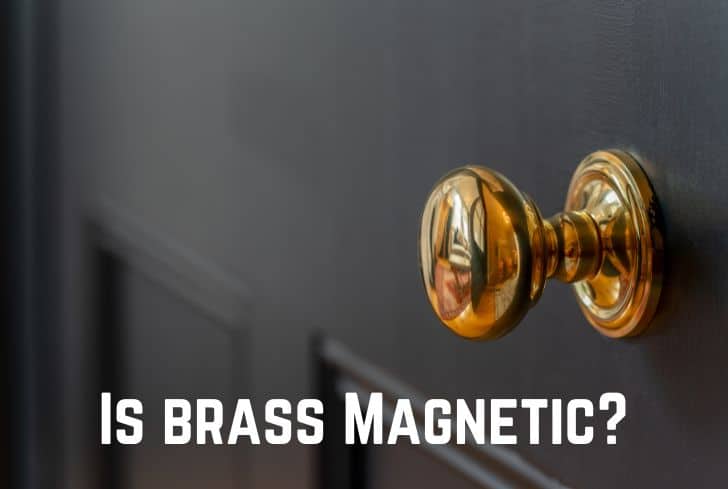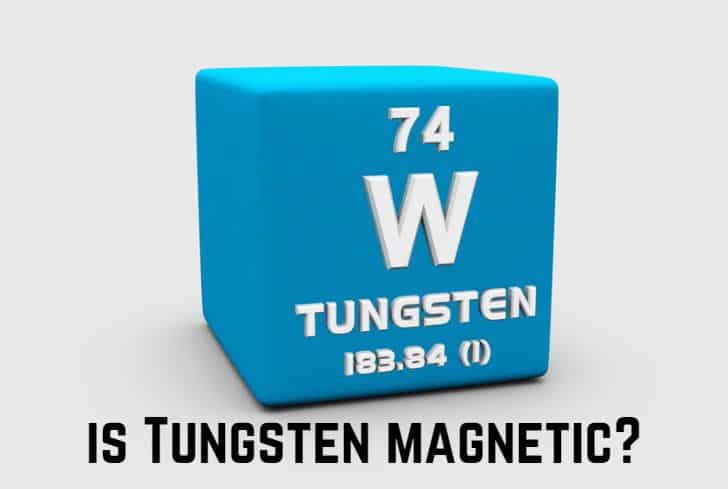Is Brass Magnetic? (Answered)

Brass is an alloy of copper and zinc, and it is similar to bronze (made up of copper and tin). In general, both alloys contain other elements including aluminium, manganese, silicon, etc. Historically, the distinction between the two has not been completely clear. Today, brass is used in a range of applications from locks to fashion jewellery.
Have you ever wondered if brass is magnetic? In this article, we are going to discuss just that. We will begin by looking at the properties and uses of brass. Then we will look at the magnetic properties of the alloy and its types. Finally, we will compare it with a few other metals.
Read: Is Lead Magnetic?
Does Brass Stick to a Magnet?
No, brass does not stick to a magnet. It is made out of copper and zinc, both of which are diamagnetic. This is because they do not have unpaired electrons in their outer shell. Acquiring the same property as its constituents, brass is also repelled by a magnetic field.
Let us first try to learn what magnetism is. Magnetism is a force caused by the motion of electric charges. Every substance is made up of atoms. These atoms have electrons (particles that carry an electric charge) that circle the atom’s centre, called the nucleus.
In some substances like iron, electrons spin in the same direction. This allows their magnetic fields to combine together and produces a magnetic field extending beyond the atoms. These objects are strongly attracted to magnets and are called ferromagnetic.
However, in most substances, equal numbers of electrons spin in opposite directions. This cancels out their magnetism, and they are not attracted to a magnetic field. These include things like paper, cloth, wood, etc. and are called diamagnetic.
Brass is made up of copper and zinc, both of which are diamagnetic materials. Their respective electron configurations are [Ar] 3d¹⁰ 4s¹ and [Ar] 3d¹⁰ 4s². Both elements have a completely filled d-orbital, with each electron paired. Due to the lack of unpaired electrons, both elements are diamagnetic.
Brass, being an alloy of these two elements, acquires the same kind of magnetism. It is not attracted by magnets. However, it still interacts with magnetic fields, as we will see in a later section.
Properties and Uses of Brass
These are the properties of brass:
- Brass is more malleable than bronze or zinc, meaning that it can be easily hammered into shape without breaking.
- It has a relatively low melting point of 900 to 940 °C (1,650 to 1,720 °F), making it an easy material to cast. Brass also exhibits low friction and is easily machined.
- Brass is also recyclable, and 90% of all brass alloys are recyclable. Because of its non-magnetic nature, brass is also easily separated from other ferrous scraps.
- Different types of brasses, hard and soft, can be made by changing the proportions of copper and zinc.
- Although brass is tarnish-resistant, it is not safe underwater. It corrodes in the presence of moisture, chlorides, and certain acids. In salt water, the zinc reacts with the minerals, so brass cannot be used for sea applications.
These are the uses of brass:
- Brass’ low friction and corrosion resistance make it ideal for locks, hinges, bearings, etc. It is also used in plumbing and electrical sockets.
- It is also used in musical instruments such as bells and horns.
- Brass is often used as a substitute for copper in fashion, costume, and imitation jewellery. Such jewellery offers greater resistance than copper jewellery.
- Brass does not generate sparks when struck, so it is vital to fittings and tools that are used near flammable materials.
- Brass also has several decorative applications such as door knobs, cabinet hardware, bathroom fixtures, etc.
Why is Brass Non-magnetic?
Brass is non-magnetic because it is made up of copper and zinc, both non-magnetic materials. The alloy acquires the diamagnetism of its constituents and is similarly not attracted to magnets. However, brass still interacts with magnetic fields.
An object is magnetic if it has unpaired electrons in its outer shell. These electrons spin in the same direction, creating a magnetic field. However, brass is made up of copper and zinc. Both of them do not have unpaired electrons.
So, like its constituents, brass is also diamagnetic, meaning that it is not attracted to magnets. However, brass still interacts with magnetic fields, just like other non-magnetic metals like aluminium, copper, etc.
When you bring a moving magnet near brass (or move the alloy instead), the movement sets up an electrical current in the brass. This current has its own magnetic field and it interacts with the magnet.
Check out this video by Atkinson Physics to see this in action. He has installed a brass plate on a pendulum, which moves freely in the absence of any magnet. But when he brings a strong neodymium magnet close to it, the brass pendulum slows down.
Read: Is Wood Magnetic?
An even more impressive trick is dropping a magnet down a thick brass, aluminium, or copper tube. You will see that the magnet’s fall is slowed down. The moving magnet causes eddy currents to form in the metal, and they have their own magnetic fields. These are what interact with the magnet and slow it down. This is called the Lenz effect.
Is Nickel-plated Brass Magnetic?
Yes, nickel-plated brass is magnetic. Nickel is a ferromagnetic material that is strongly attracted to magnets. This is because it has unpaired electrons in its outer shell. When it is used to plate brass, it gives the alloy its ferromagnetic property.
The electron configuration of nickel is [Ar] 3d⁸ 4s². It has two unpaired electrons in its valence shell. These unpaired electrons spin in the same direction, creating a magnetic field. This is why nickel is ferromagnetic: strongly attracted to magnets and retains its magnetic even in the absence of an external magnetic field.
Nickel plating makes the brass less frictional and more corrosion resistance. It also creates a less-porous barrier, so there are fewer risks of environmental elements leaking in. Unlike chromium plating, nickel plating can also be done via an electroless process.
Although brass is a non-magnetic material, when it is plated with nickel, it acquires the ferromagnetism of the metal. So, nickel-plated brass is magnetic.
Is Chrome-plated Brass Magnetic?
No, chrome-plated brass is not magnetic. Chromium is non-magnetic because it has a half-filled orbital shell ([Ar] 3d⁵ 4s¹) that is stable. Brass is also non-magnetic since it does not have any unpaired electrons. So, together, they remain a non-magnetic alloy.
Chrome plating improves the impact and corrosion resistance of brass, improving its durability. It also has a reduced risk of de-lamination, so the plating will stay for a long time. Plus, chromium plating gives a shiny, beautiful finish to the alloy.
Chrome-plated brass is expensive and is used in pistons, hydraulic cylinders, and other mechanical parts. Since both chromium and brass are non-magnetic, chrome-plated brass is also not attracted to magnets.
Brass vs Bronze
Brass and bronze are both metal alloys; the former contains copper and zinc while the latter has copper and tin. Both of them usually include other elements like aluminium, manganese, silicon, etc.
Historically, the distinction between them has not been very clear, and in earlier times, metalsmiths occasionally made one in place of the other by accident (since zinc is often found in tin). This is why museums refer to these historical objects as simply “copper alloys”.
However, there are still differences between the two alloys:
- Brass has a good level of resistance. However, zinc reacts with the minerals in salt water. Tin, on the other hand, does not react with the minerals, therefore bronze is ideal for making boat propellers and in other applications that involve salt water.
- Bronze was discovered much earlier than brass. The former dates back to 3500 BC while the latter was discovered in 500 BC.
- Bronze is hard and brittle. Brass has a much greater malleability.
Both alloys have their specific strengths and are used in a wide range of applications.
Copper vs Bronze
Copper is a base metal, which is naturally found in nature. Bronze, on the other hand, is a man-made alloy made by mixing copper with tin, and it can also include other elements like nickel, aluminium, etc. They are different in the following ways:
- Although both are resistant, bronze is more corrosion-resistant.
- Copper is the most electrically conductive metal, while bronze has only 15% of copper’s conductivity. But bronze has a much greater thermal conductivity.
- Copper melts at 1084°C (1983.2°F) while bronze’s melting point ranges between 315-1080°C (599-1976°F).
- Bronze is harder than copper, and it is also much more durable.
- In terms of machinability, copper is much better than bronze since the latter is harder.
Read: Is Aluminum Magnetic?
Conclusion
In this article, we have looked at the magnetism of brass. Because it is made up of copper and zinc, both of which are diamagnetic materials, the alloy is also non-magnetic. However, it still interacts slightly with magnetic fields. We looked at the properties and uses of brass. We also compared brass, bronze, and copper.






